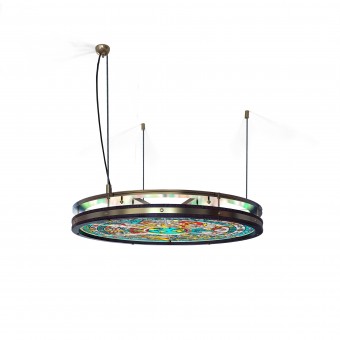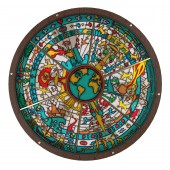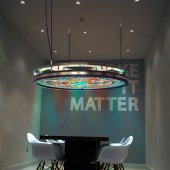
| THE AWARD |
| CATEGORIES |
| REGISTRATION |
| SUBMIT YOUR WORK |
| ENTRY INSTRUCTIONS |
| TERMS & CONDITIONS |
| PUBLICATIONS |
| DATES & FEES |
| METHODOLOGY |
| CONTACT |
| WINNERS |
| PRESS ROOM |
| GET INVOLVED |
| DESIGN PRIZE |
| DESIGN STORE |
| THE AWARD | JURY | CATEGORIES | REGISTRATION | PRESS | WINNERS | PUBLICATIONS | ENTRY INSTRUCTIONS |
Chartres Ceiling Lamp by André Teoman |
Home > Winners > Design #36482 >Interview |
 |
|
FS: What is the main principle, idea and inspiration behind your design?
AT: It’s a modern re-interpretation of the stained glass technique used in a ceiling lamp that can easily be adjusted in height and angle. The inspiration came from the cathedrals light effect in sunny days thanks to the colorful stained glass motifs that they have. I wanted to bring a bit of that magic to the home, without all the religious weight.
FS: What has been your main focus in designing this work? Especially what did you want to achieve?
AT: To break the relation between stained glass and religion, using it in as a day-to-day object of our lives with a storytelling more modern and funnier than the bible.
FS: What are your future plans for this award winning design?
AT: To sell it has a Young Guns commercial piece and produce it with the talented craftsman that I visited during the concept stage. Create sustainability within small producers is one of my objectives every time I create something.
FS: How long did it take you to design this particular concept?
AT: I started around June. I left the companies I was working for to dedicate myself to my own project. Until June I had a collection to finish and when it was done I started sketching some new concepts and Chartres was one of them. It’s not finished yet, I still need to produce it so, I can’t tell you yet how long it’s going to take.
FS: Why did you design this particular concept? Was this design commissioned or did you decide to pursuit an inspiration?
AT: I decide to pursuit an inspiration. Like I told in the last question I was sketching new concepts for a commercial collection for Young Guns, and Chartres was one of them. Since I always wanted to explore the stained glass technique it was my first choice for further development.
FS: Is your design being produced or used by another company, or do you plan to sell or lease the production rights or do you intent to produce your work yourself?
AT: I haven’t produced it yet, but I’m hoping to produce it and sell it as a Young Guns studio using outsource suppliers.
FS: What made you design this particular type of work?
AT: I was always overwhelmed by the light effect created by stained glass motifs in cathedrals, I just didn’t like the connection with the religious themes. Every time I saw one I thought to myself “one day I’m going do something with stained glass without Jesus on it”.
FS: Where there any other designs and/or designers that helped the influence the design of your work?
AT: Yeah sure, we are always being influenced since we’re born. Mainly I would say I was influenced by the cathedral glass motifs I’ve seen all my life.
FS: Who is the target customer for his design?
AT: Interior Designers, Architects or final clients. It’s for the High-End market of course, since it’s all hand made and can be arranged to all projects. This gives it a higher value since it’s always one of a kind piece, even if looking alike the “DNA” is always slightly different.
FS: What sets this design apart from other similar or resembling concepts?
AT: Mainly the colorful visual effects that it will make, the use of this technique in such a modern form and visual representations, and the possibility to adapt it very easily to any interior project.
FS: How did you come up with the name for this design? What does it mean?
AT: From all the stained glass motifs I’ve ever seen the ones in the Chartres cathedral were the greatest and the one that most impressed me, so I wanted to give the piece it’s name, hoping that it will have the same effect on it’s users.
FS: Which design tools did you use when you were working on this project?
AT: To start, a 0,4 pilot pen, a notebook, my Ipad, and some basic colors tombow pens. Then a car to visit the stained glass suppliers and learn more with them. And finally my computer with some 2D and 3D creative software to create the simulated images, my iphone for the video footage and lots of coke (coca-cola...) to keep me awake, since I don’t drink coffee.
FS: What is the most unique aspect of your design?
AT: All the complex hand work that you can feel at a first glance... and my imprint.
FS: Who did you collaborate with for this design? Did you work with people with technical / specialized skills?
AT: I worked with a local supplier of stained glass. I’m not sure if I can mention his name. They received me with open harms and gave me a detailed explanation about the technique itself, it’s boundaries and it’s abilities.
FS: What is the role of technology in this particular design?
AT: I normally don’t get very involved with technology in my creations. I prefer to innovate traditional techniques that are endangered to disappear by giving them the opportunity to shine again and live.
FS: Is your design influenced by data or analytical research in any way? What kind of research did you conduct for making this design?
AT: Not at all. All my research was technical, and visual around the technique of stained glass, how to tell a modern story with it and how to get that magical colorful light effect.
FS: What are some of the challenges you faced during the design/realization of your concept?
AT: The structure of the lamp itself. To combine a 6 colored stained glass with an exact form and other materials was the hardest part. Finding the right aesthetic balance to make it appealing was difficult but quite satisfying to see in the end result.
FS: How did you decide to submit your design to an international design competition?
AT: Because it’s the first time that I am doing a piece on my own, without a brand or a person supporting it, I need this to show myself to a bigger crowd.
FS: What did you learn or how did you improve yourself during the designing of this work?
AT: Everything I learned about the technique and the people I meet are the best things I have taken from this project, besides the opportunity to explore the piece a little deeper. Normally in brands they want the shell but don’t give you time to get to the core of it because you already started a new piece. I really got the chance to go deep in this piece and experience what it really means to get to its peak.
FS: Any other things you would like to cover that have not been covered in these questions?
AT: No further remarks, thank you very much.
FS: Thank you for providing us with this opportunity to interview you.
A' Design Award and Competitions grants rights to press members and bloggers to use parts of this interview. This interview is provided as it is; DesignPRWire and A' Design Award and Competitions cannot be held responsible for the answers given by participating designers.
| SOCIAL |
| + Add to Likes / Favorites | Send to My Email | Comment | View Press-Release |




